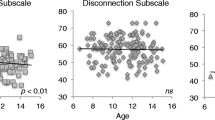Abstract
This study investigated the effects of two levels of teacher intrusion upon the behavior of elementary age children with autism and nonhandicapped peers during dyadic play interactions occurring in two special education classrooms. High versus low levels of teacher intrusion were contrasted in a mixed between- and within-subjects design counterbalanced for order across the two conditions. There were few differences in behavior across the two conditions, though the low-intrusion condition was associated with higher levels of toy contact, appropriate and inappropriate play, and lower levels of spontaneous verbalizations by the students with autism. There was no difference in the occurrence of excess behavior by condition. Results are discussed with respect to future investigations of effective teacher mediation to prepare children for positive peer interactions.
Similar content being viewed by others
References
Biklen, D. (1985).Achieving the complete school: Strategies for effective mainstreaming. New York: Teachers College Press.
Brady, M. P., Shores, R. E., Gunter, P., McEvoy, M. A., Fox, J. J., & White, C. (1984). Generalization of an adolescent's social interaction behavior via multiple peers in a classroom setting.Journal of The Association for Persons with Severe Handicaps, 9, 278–286.
Brinker, R. (1985). Interactions between severely mentally retarded students and other students in integrated and segregated public school settings.American Journal of Mental Deficiency, 89, 587–594.
Certo, N., Haring, N., & York, R. (Eds.). (1984).Public school integration of severely handicapped students: Rational issues and progressive alternatives. Baltimore: Paul H. Brookes.
Charlop, M. H., Schreibman, L., & Tyron, A. S. (1983). Learning through observation: The effects of peer modeling on acquisition and generalization in autistic children.Journal of Abnormal Child Psychology, 11, 355–366.
Cole, D. A. (1986). Facilitating play in children's peer relationships: Are we having fun yet?American Educational Research Journal, 23, 201–215.
Cole, D. A., Meyer, L. H., Vandercook, T., & McQuarter, R. J. (1986). Interactions between peers with and without severe handicaps: The dynamics of teacher intervention.American Journal of Mental Deficiency, 91, 160–169.
Coleman, S. L., & Stedman, J. M. (1974). Use of a peer model in language training in an echolalic child.Journal of Behavior Therapy and Experimental Psychiatry, 5, 275–279.
Donder, D., & Nietupski, J. (1981). Nonhandicapped adolescents teaching playground skills to their mentally retarded peers: Toward a less restrictive middle school environment.Education and Training of the Mentally Retarded, 16, 270–276.
Donnellan, A. M. (1984). The criterion of the least dangerous assumption.Behavioral Disorders, 9, 141–150.
Egel, A. L., Richman, G., & Koegel, R. L. (1981). Normal peer models and autistic children's learning.Journal of Applied Behavior Analysis, 14, 3–12.
Hughes, V., Wolery, M. R., & Neel, R. S. (1983). Teacher verbalizations and task performance with autistic children.Journal of Autism and Developmental Disorders, 13, 305–316.
Johnson, R. E., & Meyer, L. (1985). Program design and research to normalize peer interactions. In M. P. Brady & P. L. Gunter (Eds.),Integrating moderately and severely handicapped learners: Strategies that work (pp. 79–101). Springfield, IL: Charles C Thomas.
McHale, S. M., & Simeonsson, R. J. (1980). Effects of interaction on nonhandicapped children's attitudes toward autistic children.American Journal of Mental Deficiency, 85, 18–24.
Meyer, L. H., McQuarter, R. J., & Kishi, G. S. (1985). Assessing and teaching social skills. In S. Stainback & W. Stainback (Eds.),Integration of students with severe handicaps into regular schools (pp. 66–86). Reston, VA: The Council for Exceptional Children.
Sailor, W., & Mix, B. J. (1975).The TARC Assessment System. Lawrence, KS: H & H Enterprises.
Strain, P. S., Odom, S. L., & McConnell, S. R. (1984). Promoting social reciprocity of exceptional children: Identification, target skill selection, and interventions.Remedial and Special Education, 5, 21–28.
Voeltz, L. M. (1980). Children's attitudes toward handicapped peers.American Journal of Mental Deficiency, 84, 455–464.
Voeltz, L. M. (1982). Effects of structured interactions with severely handicapped peers on children's attitudes.American Journal of Mental Deficiency, 86, 380–390.
Voeltz, L. M., & Brennan, J. (1984). Analysis of interactions between nonhandicapped and severely handicapped peers using multiple measures. In J. M. Berg (Ed.),Perspectives and progress in mental retardation: Vol. 1. Social, psychological, and educational aspects (pp. 61–72). Baltimore: University Park Press.
Voeltz, L. M., Kishi, G., & Brennan, J. (1981).SIOS: Social Interaction Observation System. Honolulu: University of Hawaii Department of Special Education.
Will, M. (1983, November). Keynote Address. Tenth annual conference of The Association for Persons with Severe Handicaps, San Francisco.
Wuerch, B. B., & Voeltz, L. M. (1982).Longitudinal leisure skills for severely handicapped learners: The Ho'onanea curriculum component. Baltimore: Paul H. Brookes.
Author information
Authors and Affiliations
Additional information
This work was supported in part by Contract #300-82-0363 from Special Education Programs, U.S. Department of Education, awarded to the University of Minnesota. The material does not necessarily reflect the position or policy of the U.S. Department of Education, and no official endorsement should be inferred. The authors gratefully acknowledge the assistance and support of Bonnie Biel, Marie Blackburn, Dennis McGuire, Ralph McQuarter, May Ross, Jeanne LaMere, Etta Overland, Barbara Pollster, and Mary Porter in the conduct of this study.
Rights and permissions
About this article
Cite this article
Meyer, L.H., Fox, A., Schermer, A. et al. The effects of teacher intrusion on social play interactions between children with autism and their nonhandicapped peers. J Autism Dev Disord 17, 315–332 (1987). https://doi.org/10.1007/BF01487063
Issue Date:
DOI: https://doi.org/10.1007/BF01487063




